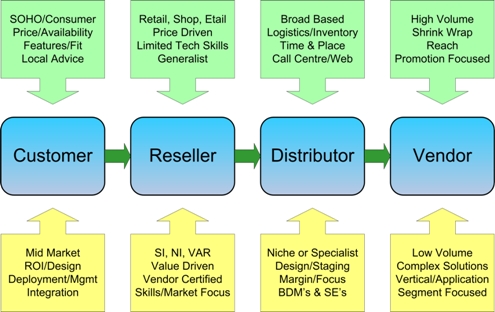Vendors often measure, profile and segment their partners and distributors based on revenue performance, but rarely do they dig deeper to look beyond the numbers to the driving forces behind the strategy.
This article looks at tips to ensure your business is aligned to the right match of distribution partners, and therefore the right reseller partners, and ultimately their customer base.
Different Reseller Skills & Needs
The fundamental basic of any profitable and strong vendor and distribution relationship is that of alignment. Sounds simple, but often more difficult than one might imagine to sustain on an ongoing basis.
The Channel Dynamics DynamicDSI model states that first we must Define the customer/market for our products or services, then Select the appropriate partners (both distributors and resellers), and finally Implement the necessary supporting processes and resources so that our channel partners can meet the needs of our customers, profitably. For instance the needs and buying preferences of a SMB end user are very different from that of a larger corporate customer.
Resellers build their business model (skills, profit mix, growth aspirations, technologies, key vendor partners and associated costs) around how they believe they can offer a competitive and differentiated service to their targeted customers. I.e. compare a SoHo/SMB (5-50 employees) reseller (who is often also an SMB) to that of a larger VAR targeting mid market (250+ employees) and above
If the reseller is a reflection of the needs of customers they service,
it follows the reseller’s needs and what they value from distribution
will also change.

The first step is to see if your current distribution partners are basically aligned with your business strategy. Are you looking for a transactional “time & place” distributor as you have a mature product that needs broad reach, or do you need special skills both in the distributor and reseller due to the complexity of the product or solution?
The resellers a distributor looks to engage with (profitably) and service will usually be a reflection of the vendors they represent, which in turn of course reflect the type of customers your product/solution is targeting. It is often easier to work backwards from the customer rather forwards from the vendor to the channel to check alignment.
However alignment “creep” can occur over time and can be caused by any one of changes listed below and some are equally applicable to both the vendor and the distributor. Therefore as a start check to see how many of these events have happened in the last 12 months.
Vendor
- Develops/releases new products
- Acquisitions
- Strategy/market focus extension/addition
- Market dynamics/conditions
Distributor
- Expansion to new locations
- Capability, logistics or operational
- Vendor line up (both in and out)
- Profitability, cash flow, financial pressure
Distribution Alignment Check
The Distribution Alignment Checklist is a simple and straight-forward tool to help you determine the level of alignment between your organisation and that of your distributor(s).
{module_literature,i,56357}
Before you start looking for another distributor, firstly review your alignment using this tool, and see how you score. Do you have a complementary philosophy around Customers, Logistics, Resources, Programs, Engagement, etc? Sometimes poor revenue performance is not always the fault of the distributor!
If you decide that you need to change your distribution partner, you also need to think about why a distributor would want to represent you. Most distributors have a selection process for deciding which vendors they would want to represent. This could include criteria for minimum revenue, profit, market share, growth, competitive distribution, weighed up against resource investments, as well as strategic reasons such as looking for a complementary vendor to complete their existing portfolio.
Ultimately the mix of distributors needs to be aligned to your business strategy and so being able to provide sustainable market coverage while complementing the activities of the vendor.
Best Practice For Building Distribution Alignment
- Start at the beginning to ensure your distributors and the partners they service (including financial returns, partner responsibilities and opportunities) are aligned to the market you wish them to address, and you are not trying to force “square pegs”…..
- Does everyone within your organisation agree as to what you expect from or why you have the current channel structure? Has anything changed?
- Not all distributors are the same, so don’t treat them as if they are just a “bank & a warehouse”. Take the time to understand their strengths and drivers
- If making changes to your distribution network profile the distributors and see how they align to your business strategy and the points above.
- Review and share your channel plans and strategy with your key distributors on a regular basis. This is more than just the quarterly numbers to ensure that any changes in alignment on either side can be managed appropriately, without surprises.
- Have a channel plan and stick to it. If you have to change policies, resources, programs or margins, think through the channel consequences and provide ample warning and an explanation of why


